 |
 |
 |
| |
Body mass index (BMI) and change in levels of immune activation post-
ART initiation in diverse low- and middle-income settings
|
| |
| |
IAC: Higher One-Year Risk of CVD or Diabetes Per BMI Unit Gained on ART (07/23/14)
IAC: Inflammation/Activation Markers Drop With ATV, DRV, RAL, But Not Completely - ACTG Study (07/23/14)
there were significant correlations between increased hsCRP and greater BMI (p=0.005), higher non-HDL (p=0.013) and triglycerides (p=0.017), and lower HDL (p=0.015)......http://www.natap.org/2008/IAS/IAS_88.htm.
subjects with moderate-to-severe lipoatrophy were over four times as likely to have hypertension (OR 4.3; 95% CI 1.2-15.6; P=0.03) as subjects reporting no abnormalities, while those with mild lipoatrophy were approximately twice as likely to have hypertension; this latter difference was not statistically significant (OR 2.0; 95% CI 0.9-4.2; P=0.08).......http://www.natap.org/2009/HIV/052709_06.htm
Calorie restriction in adult men and women causes beneficial metabolic, hormonal, and functional changes, but the precise amount of calorie intake or body fat mass associated with optimal health and maximum longevity in humans is not known. In addition, it is possible that even moderate calorie restriction may be harmful in specific patient populations, such as lean persons who have minimal amounts of body fat.......BMI between 18.5 to 24.9 is normal, because BMI values below or above this range increase the risk for premature mortality.125-127 Data from epidemiologic studies that evaluated the relationship between BMI and risk of type 2 diabetes128 and from studies of individuals who have undertaken long-term calorie restriction90 -92 suggest that a BMI at the low end of normal, ≈ 20, is associated with optimal metabolic and cardiovascular health......http://www.natap.org/2011/newsUpdates/122211_03.htm
Visceral fat is associated with lower brain volume in healthy middle-aged adults......http://www.natap.org/2010/HIV/052010_01.htm
Reported by Jules Levin
20th International AIDS Conference, July 20-25, 2014, Melbourne
Vidya Mave1, Nikhil Gupte1, Kristine Erlandson2, Ashwin Balagopal1, David Asmuth3, Wei Teng Yang1, James Hakim4, Thomas Campbell2, Amita Gupta1 for the NWCS 319 Study Team
1. Johns Hopkins University, Baltimore, USA, 2. Univ of Colorado Denver, Aurora, CO, US, 3. Univ California Davis, Sacramento, CA, US, 4. Univ of Zimbabwe, Harare, Zimbabwe

--------------------
Program Abstract
Background: High BMI is associated with increased immune activation in high-income settings, which in turn is associated with increased risk of non-AIDS events. The relationship between BMI and chronic immune activation pre- and post-antiretroviral therapy (ART) initiation in low and middle income settings is unknown.
Methods: Markers of immune activation (TNF-α, IFN-γ, IL-6, IL-18, IP-10, CRP, LPS, sCD14) were measured in a country stratified random sample of 270 participants from ACTG PEARLS trial
(trial of 3 ART regimens in Brazil, Haiti, India, Malawi, South Africa, Thailand, Zimbabwe and US) at week 0, and week 24 and week 48 post-ART initiation. 24 participants who did not achieve virologic suppression at week 24 and 48 were excluded. Baseline BMI (kg/m2) was categorized as low
(≤ 18.5), normal (18.5-24.9), and high (≥ 25). Effect of baseline BMI on longitudinal changes in biomarkers adjusting for age, sex, country, treatment, screening CD4 and baseline viral load, was assessed using random effects models.
Results: Of 246 participants, 125 (51%) were males; median age, baseline CD4 and VL were 35 (IQR, 30-41) years, 139 cells/ mm3 (86 - 230), and 5.1 log 10 copies/ ml (4.6 - 5.5), respectively. 19 (8%) had low, 163 (66%) normal and 64 (26%) high BMI. Baseline BMI significantly differed for age and country, and showed a trend for CD4 and VL. Week 0 distribution of markers was comparable among all BMI categories except TNF-α which was higher in low BMI participants (p=0.005). Compared to normal BMI, high BMI was associated with less of an average decrease for TNF-α, IFN-γ, IL-6, IL-18, IP-10, CRP from week 0 to 48; this reached statistical significance for CRP
(-13.2, 95% CI, -22.7, -3.7, p=0.007) and IL-18 (-233.1, 95% CI, -443.4, -22.8; p = 0.03). Similarly, low BMI was associated with less of a decrease for TNF-α, IFN-γ, IL-18, CRP; this also reached statistical significance for CRP (-11.8, 95% CI, -20.37, -3.2; p=0.007) and IL-18 (-230.4, 95%CI, -423.8, -37, p=0.02).
Conclusions: Low and high BMI are both associated with less decrease in immune activation as measured by CRP and IL-18 during the first 48 weeks of ART.
---------------------


|
| |
|
 |
 |
|
|